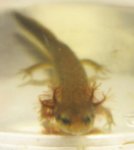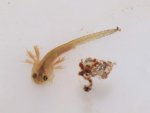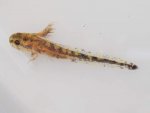A few, general, quick tips for identifying larval salamanders:
- Look for where the dorsal tail fin starts. If it starts on the body (i.e., anterior to the hind legs and hips), then it has what they call the "pond type" morphology. This doesn't mean that the critter necessarily lives in a pond, though, but it will rule out many species. Both newt larvae and spotted salamander larvae will have tail fins that originate anterior to the hind limbs. The first photo attached one of my photos of a very young, spotted salamander larva. The second is of a mole salamander (Ambystoma talpoidium) larva, which more clearly shows where the tail fin originates in Ambystoma larvae (on the body). Your little guy doesn't have a tail fin that passes the hind legs, so it's neither of these. Ambystoma also have hilariously large heads as larvae.
- Count the number of hind toes. If you count only 4, look again, and look very closely. The "thumb" of the hind foot on larvae can be very small, and it's easy to miss it. Your larva will have 5 toes on the hind limbs, which also rules out newts.
- Larvae can sometimes look nothing like adults, especially if young (i.e., that mole salamander larva is beautifully patterned, but the adults have none of that pattern), so be wary if you're trying to match larval pattern to adult pattern.
Your guy/gal is some type of
Eurycea, a "brook salamander."
From a quick Google search, it looks like Ohio has three species of
Eurycea, the two-line (
E. bislineata), the longtail (
E. longicauda), and the cave salamander (
E. lucifuga). Based on the location you gave, the two-line and the cave appear to be out of range (used range maps from this site
OhioAmphibians.com: Frog & Toad Calling Survey, Salamander Monitoring Program), so perhaps it is the longtail?
Of these three species, I've only had experience with the two-lined salamander, so perhaps someone else will comment who has more applicable experience. I've also not herped in Ohio, and if there have been revisions to range maps, I don't know about them.








